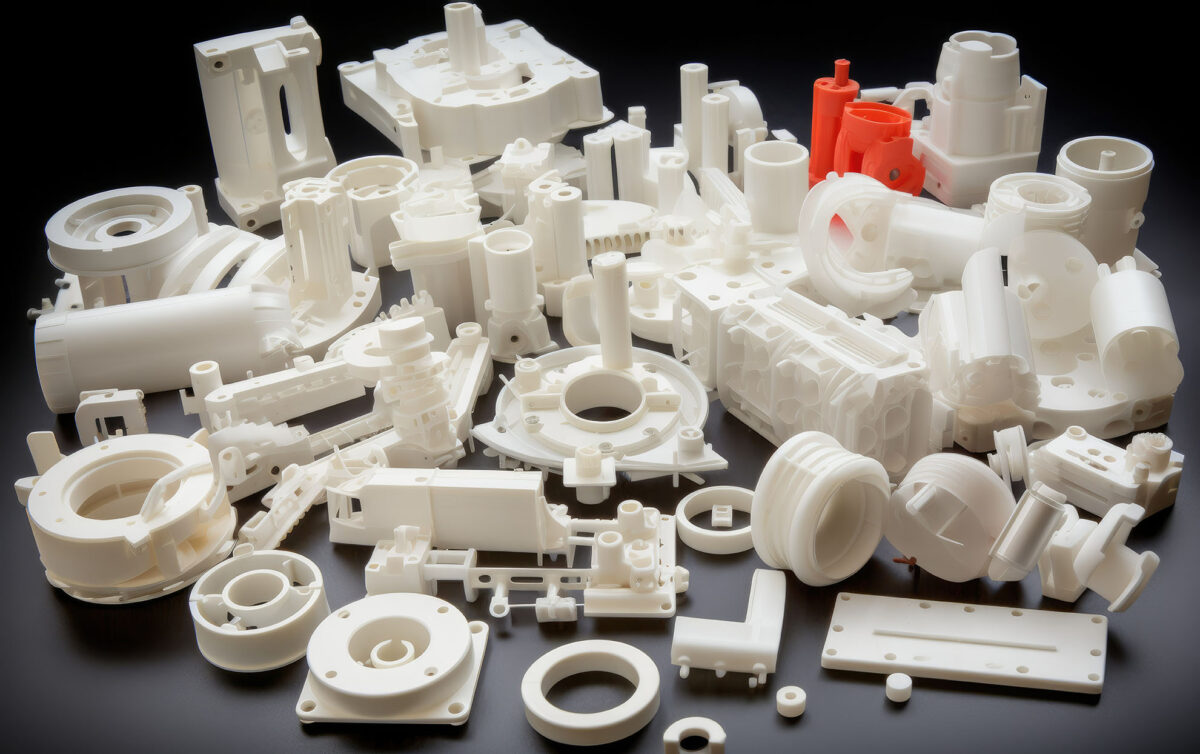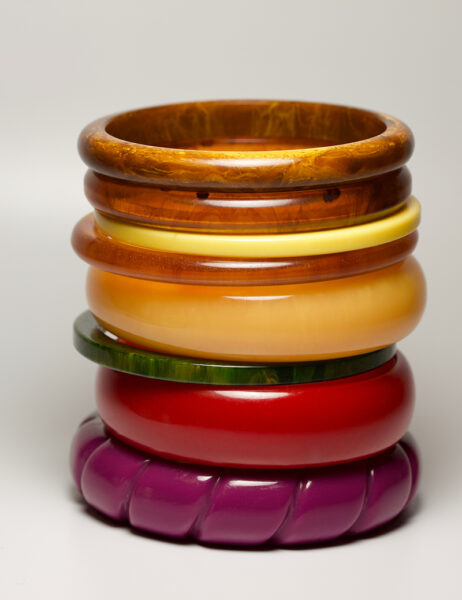Plastic Part Design for Economical Injection Molding – Part I

It is difficult to imagine but there was a time when there were no man-made plastic materials and no injection molding process.
This article originally appeared on the SPE Product Design and Development Division website, written by Glenn Beall. SPE has recently announced that the ANTEC® 2024 program will feature a Symposium Honoring the Career Achievements of Mr. Glenn Beall. His indelible legacy has significantly contributed to the growth of plastics and SPE.
The first man-made plastic was cellulose nitrate (celluloid) discovered by John Wesley Hyatt in 1868. This was followed by Leo H. Baekeland’s 1907 invention of phenol formaldehyde (Bakelite). Celluloid was readily colorable. It found wide usage as a substitute material for all kinds of consumer products. Large markets developed for pigmented sheet stock and transparent celluloid in photographic films and cellophane packaging applications.

Vintage bakelite bracelets.
Bakelite was a stronger material with better heat and chemical resistance but it was only available in dark colors. It became the material of choice for industrial products. This was especially true for applications that could benefit from it’s excellent electrical insulating capabilities.
The fledgling Plastics Industry continued to grow. Molding processes were refined and a few new plastic materials (notable Nylon first patented in 1931) were introduced, however the growth was modest. That changed abruptly in the early 1940’s when World War II created critical shortages of steel, aluminum, copper, rubber and just about everything else.
That was a terrible war but it was a golden opportunity for the Plastics Industry. These relatively new materials and molding processes were rushed into production to make up for the shortages. The need was bigger than the industry. Many well meaning technical people with no formal plastic training and no experience were forced into service. Colossal mistakes were made in material selection, design, tooling and processing. Some of those misapplications made it to the front lines with catastrophic results.
Back in those days if the uninitiated wanted to replace a fabricated sheet steel or die cast aluminum housing with plastic they would make a cavity the same size and shape as the metal housing. They would then discover that they could not fill the cavity. Increasing melt temperature and pressure helped a little. Opening the gate also helped, but they still could not mold a full part. It finally became apparent that the wall thickness of the part would have to be increased for the melt to flow that far.
Once they had a full part they discovered they could not eject the straight sided part off of the core. By the expensive and time consuming process of trial and error these early plasticians learned about molding draft angles, corner radii, and the advantages of a uniform wall thickness.
By the end of the War in 1945 there were a significant number of plastics processors who had learned how to use plastic materials to their best advantage. These companies quickly converted from war time to peace time production to take advantage of the pent-up demand for consumer products. Unfortunately the experienced processors could not keep up with the demand. This created an opportunity for the less or inexperienced manufacturers to start producing plastic products. Many mistakes were made and a lot of shabby plastic products were released into the market. Plastics war time reputation as a miracle substitute material was suddenly reduced to that of being a cheap, imitation plastic material. Some people still retain that unfavorable impression.
By the early 1950’s an actual Plastics Industry was taking shape and expanding. Unfortunately there were not enough technically competent people to take advantage of all of the possible new applications. More inexperienced manufacturers joined the Plastics Industry and contributed their share of low quality products.
The plastic material manufacturers had a financial interest in the success and growth of a Plastics Industry. They concluded that for this industry to reach its full potential, plastics processors needed a better understanding of the technology governing the use of these materials. They were aware that the Universities were not producing plastics engineers or technicians. They finally came to realize that the plastic material manufacturers themselves would have to undertake the gigantic task of educating the plastics processing industry.
All through the 1950’s, 60’s, and 70’s the resin manufacturers visited processors and wrote technical articles for trade magazines, presented technical papers at conferences, and published some of the best technical brochures ever produced. There were brochures explaining all of the different plastic materials, others described how to design molds, or set up and run an injection molding machine, or how to dry material. Simultaneously the same thing was happening with extrusion, thermoforming, blow molding and all of the other processes.
Most of the material suppliers also published brochures on how to design plastic parts to be molded using their materials. In my career as a product designer these old brochures became bibles. They still enjoy a place of prominence in my library. The brochures covered all of the basics of part design. Over the years those basics have not changed. All that is different now is that we enjoy a better understanding of the basics and we have the advantage of computer aided engineering.
We owe the plastic material manufacturers a debt of gratitude for their efforts in educating the early Plastics Industry. We must also be thankful for the rich collection of design information that they produced. These old design brochures contain the details that allow the design of parts and products that are ideally proportioned for the combination of the material and the molding process chosen for a given project. The proper design of a new plastic product is important. But why?
Product Design is Important
Deloitte and the Manufacturing Institute have determined that every dollar spent in manufacturing adds $1.37 to the U.S. economy. They also estimate that every 100 manufacturing jobs results in the creation of another 250 jobs in other segments of the economy. A strong manufacturing industry is important to the financial well being of the country. It is a sobering but true fact that manufacturing can only produce what engineers design. If there is no product design, there is no need for a plastic material, a mold or a molding machine. There is nothing to mold and nothing to sell. No jobs are created and no profit is made.
If the product design is properly proportioned for the plastic material and the molding process being used, a high quality, low cost part can be produced. The owner of that part will be in a good position to overcome offshore competition.
If the product design is not properly proportional for the material and the process, the product will never achieve its full potential. On the other hand if the designer created a structure that turns out to be one of those MUST HAVE products, magical things begin to happen. But why do they happen?
They happen because the molder had to buy some plastic material in order to mold these parts He then hires someone to assemble those parts to make a toy. He also purchases a box to put it in. He then has to hire a trucker to deliver the toy to Walmart. If you could ever find a clerk at Walmart, you could buy one of those toys. If you did, somebody else at Walmart would ring up that sale. Once a day an accountant would total up those sales. And then everybody up and down the supply chain will get paid. Once they were paid, taxes will be collected. The government takes those taxes and hires a special investigator to spy on President Clinton and Monica Lewinsky. Meanwhile the television industry will reap millions of dollars in advertising sales by informing the world that the little blue dress was actually made in a sweatshop in Asia.
If there is any money left over, the government then builds a new road. That road will not be where a road is needed, but nonetheless they will build a road. It will be a beautiful road. Four lanes in both directions finished off with curbs, gutters and sidewalks with well kept flowers and trees in the lighted, grassy median. You and I can then drive down that road to go to work to make more money. And with that money, we can buy a bigger car, a sports utility vehicle, a Hummer or maybe even a Tesla. We can then drive down the road in style to take our kids to college, or go on vacations, buy plastic luggage, stay in hotels, and eat in expensive restaurants. And as we do that, the great American wheel of commerce begins to turn. And why does it turn? It turns because some engineer designed a part or a product that was not just good enough to get by, but was a great part that satisfied a marketplace need or an opportunity.
If the plastics industry wants to continue to be a part of that stream of commerce it is important for all engineers to know how to design high quality plastic parts and product that can be efficiently produced. And that brings us to the subject for the next article in this series which will be a brief review of how plastic products are or should be designed.
